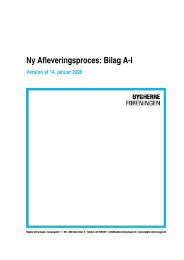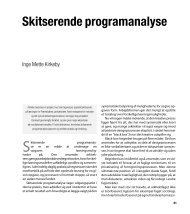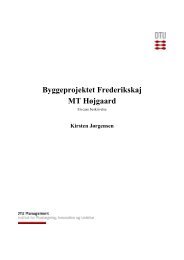Udvælgelses- dan og tildelingskriter ske byggesektor ... - RenProces
Udvælgelses- dan og tildelingskriter ske byggesektor ... - RenProces
Udvælgelses- dan og tildelingskriter ske byggesektor ... - RenProces
Create successful ePaper yourself
Turn your PDF publications into a flip-book with our unique Google optimized e-Paper software.
184 A Diverse Understanding of Value in the Building Industry<br />
1.1 INTRODUCTION<br />
For participants in building projects value is a central component in one<br />
way or another. For the client value is what he receives in terms of design,<br />
usability and quality compared with the amount of money he spends. For<br />
the contractor, the consultant, the architect, etc. value is to contribute to the<br />
fulfillment of the customer’s requirement in such an efficient manner that a<br />
satisfying contribution margin occurs. For all parties value can also be the<br />
joy of working in a dynamic project-orientated industry where unique assets<br />
designed for a specific customer are created in every project.<br />
Value is however not an integrated part of “construction thinking”. A<br />
large diversity in the understanding and use of the term value does exist. In<br />
one case the use of the word “value” in written materials (reports, project<br />
descriptions, etc.) was examined (Wandahl 2004). The result was a list<br />
with over 40 entries with a remarkably large range, e.g. value chain, ethical<br />
value, long-term value, value-based design, etc. Since a common<br />
understanding of value in building is missing, the full potential of the<br />
management concepts based on value will most likely not occur. Hence,<br />
there is a need for a deeper knowledge about the value concept, and also<br />
a need for a deeper knowledge about how different parties in the building<br />
industry perceive and use the value concept.<br />
1.1.1 Research Objectives<br />
In a general term the research objective was to gain more knowledge<br />
about the value concept in building, especially how value is handled in<br />
every day practice. More specific, the research objective was described<br />
thorough a hypothesis:<br />
Practitioners in the building industry have a vague knowledge of<br />
the value concept. Furthermore, the degree of knowledge<br />
differs between the trades.<br />
The hypothesis was developed on a compound of non-documented<br />
observations from building practice, indications from theory and<br />
government reports, and from the fact that value has been an issue in<br />
research and practice in other industries.<br />
1.2 METHODOLOGY<br />
A biased approach was applied. Both quantitative data collection through a<br />
questionnaire addressed to practitioners in the building industry, and<br />
qualitative data collections through observations from a social experiment<br />
were carried out. In a theory of science perspective, this is called<br />
triangulation. The validity of the result should, therefore, increase. The<br />
184










